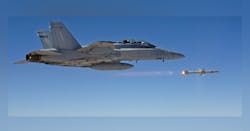Navy asks Alliant Techsystems to redesign circuit card for AARGM-ER missile using open-systems architecture
PATUXENT RIVER NAS, Md. – U.S. Navy airborne electronic warfare (EW) experts needed a company to design a new guidance processor circuit card assembly for the AGM-88G radar-killing missile. They found their solution from Alliant Techsystems Operations LLC, a subsidiary of Northrop Grumman Corp., in Northridge, Calif.
Officials of the Officials of the U.S. Naval Air Systems Command at Patuxent River Naval Air Station, Md., are asking Alliant Techsystems to redesign the guidance processor circuit card assembly of the AGM-88G Advanced Anti-Radiation Guided Missile-Extended Range (AARGM-ER) anti-radar missile.
Navy experts are asking Alliant Techsystems to use the open-system-architecture approach in support of the AGM-88 air-to-ground missile program, Navy officials say.
The new circuit card is part of a form, fit, and function replacement in the control section of the AARGM-ER. For this project Northrop Grumman experts will use a open-systems architecture approach.
Related: Northrop eyes open-systems architecture AARGM-ER upgrade
The missile upgrade project also includes the integration and delta qualification of the NAVSTRIKE-M Global Positioning System (GPS) receiver and reprogramablity functionality on completion of an advanced configuration of the AGM-88E anti-radar missile.
The new circuit board design for the AARGM-ER will address parts obsolescence, system security enhancements, reprogramablity, and support future growth capabilities using an open-systems architecture. Improvements will be cut into the AGM-88G production during low-rate initial production (LRIP) III.
The Navy is awarding this order to Northrop-Grumman sole-source because the company, as the AARGM-ER prime contractor, is considered to be the only responsible source and no other supplies or services will satisfy military requirements.
The AGM-88G AARGM-ER is an advanced radar-killing missile designed to enable the Navy F/A-18G Growler and F-35C jet fighter-bombers, as well as the U.S. Air Force F-35A jet fighter-bomber, to suppress enemy air defenses preceding bomber attacks.
The AARGM-ER is an advanced and extended-range version of the High-Speed Anti-Radiation Missile (HARM). It is a new variant of the AGM-88E missile that equips Navy carrier-based fighter-bombers and electronic warfare jets. HARM was a replacement for the AGM-45 Shrike anti-radiation missile, which was in service from 1965 to 1992.
AARGM is a supersonic, medium-range, air-launched tactical missile compatible with U.S. and allied strike aircraft. The AARGM-ER missile features several upgrades to the AGM-88E that focus on extending the weapon's operational range and survivability.
Related: Embedded computing enclosures go standard, and go small
The AARGM-ER replaces the missile's rocket motor and tail to increase its range, while keeping the sensors and electronics of the AARGM-88E, which are being upgraded in a separate project. The AARGM-ER missile is scheduled to achieve initial operating capability (IOC) and start being fielded to Navy squadrons in 2023.
AARGM-ER uses the existing guidance system and warhead of the AGM-88E with a solid integrated rocket-ramjet for double the range. The new missile uses the AARGM's warhead and guidance systems, and uses a more powerful propulsion system that reportedly increases range over the AGM-88E by 20 to 50 percent, which would give the AGM-88G a range of about 96 to 120 nautical miles.
For more information contact Northrop Grumman Mission Systems online at www.northropgrumman.com, or Naval Air Systems Command at www.navair.navy.mil.
About the Author
John Keller
Editor-in-Chief
John Keller is the Editor-in-Chief, Military & Aerospace Electronics Magazine--provides extensive coverage and analysis of enabling electronics and optoelectronic technologies in military, space and commercial aviation applications. John has been a member of the Military & Aerospace Electronics staff since 1989 and chief editor since 1995.
